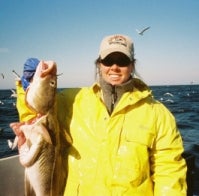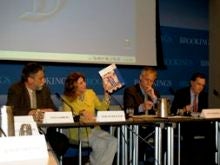A sustainable aquaculture industry in the United States has the potential to provide both environmental and economic benefits — and EDF is committed to supporting legislation that prioritizes strong regulations while supporting the industry’s efforts to make sure those benefits are felt broadly. That’s why EDF connected with Imani Black, founder of Minorities in Aquaculture, or MIA, to understand how we can foster more diversity and inclusivity in the traditionally white, male aquaculture industry. Read our conversation below to learn why Imani founded MIA, her prescriptions for a growing industry and why she believes the work she loves can give everyone an equal opportunity to thrive. Read More
EDFish
Selected tag(s): EDF
Inclusivity & Aquaculture: An interview with Imani Black
Kate Bonzon Responds to the Pew Catch Share Report
 I was hoping the Pew Environment Group’s new report, Design Matters: Making Catch Shares Work would provide some good information about how to design catch shares, but instead I found it over-simplistic, somewhat confusing and lacking any new insight into catch shares and effective design. Just about everyone agrees that catch shares can and should be designed for the unique needs of fisheries and the communities that depend on them.
I was hoping the Pew Environment Group’s new report, Design Matters: Making Catch Shares Work would provide some good information about how to design catch shares, but instead I found it over-simplistic, somewhat confusing and lacking any new insight into catch shares and effective design. Just about everyone agrees that catch shares can and should be designed for the unique needs of fisheries and the communities that depend on them.
EDF has been working on catch share design for years, and recently released a 100+ page draft of a Catch Shares Design Manual that outlines a roadmap for designing catch shares based on experience from around the world. (After an open peer review is done, we’ll finalize the manual.) I agree with the title of Pew’s report. Design of catch shares does matter. It matters a lot.
The overall feeling I left with was that Pew is comparing catch shares to an ideal world that doesn’t exist rather than to the reality of current management. The report identified many issues that traditional management hasn’t solved, and makes the case that catch shares should solve all of those problems.
The good news is that catch shares generally do make progress on those problems—and as they are adjusted over time they get even better. These include setting an accurate, science-based cap, establishing an appropriate monitoring and enforcement program, managing multiple species, reducing bycatch and habitat destruction, and compensating fishermen who are caught in a system that has led to over-capitalization.
Pew is right that these are tough problems for fisheries, but they neglect to mention that catch shares are better at achieving positive outcomes than nearly any other management approach currently in use. For example, Pew says:
“In some fisheries, improvements were more likely the result of hard TAC limits than an IFQ system.”
What they failed to mention is that not only are catch share fisheries more likely to have a hard catch limit, but fishermen are also far more likely to stay within the identified catch limits. And, the science behind those catch limits is also dramatically better than it was before catch shares were implemented. In short, catch shares lead to more accurate science-based catch limits and fishermen who come in below catch limits, 5% on average.
Good Advice for Seafood Lovers
Ever stare at the seafood counter and wonder where all that fish comes from? Maybe not, but I do, and a new article in Martha Stewart’s Body+Soul magazine wades through some other issues that might be on your mind – overfishing, fish farming, omega-3s and mercury.
Although the article sugar coats a few things (e.g. wild fish generally being a safe, sustainable option – not true), it contains some good advice. First and foremost – get to know the people that sell you fish. They can be your best ally in making good choices and are often a wealth of knowledge.
Second, don’t be afraid to ask questions like, ‘Where is this fish from?’, ‘Is it farmed or wild?’, etc. This will help steer you in the right direction.
Third, its OK not to know all the answers. The seafood market is a big, confusing place. Luckily EDF’s Seafood Selector has done the hard work for you, and provides clear guidance on what fish are healthy for you and the oceans. Its available online, in print, and optimized for mobile devices.
Our oceans are in trouble, and seafood lovers are on the front lines of the crisis. Making smart choices at the fish counter (and in restaurants) can go a long way towards revitalizing our critical marine ecosystems.
EDF/Brookings Event, Steps for U.S.-Cuba Cooperation on Oceans
At least on the surface, relations between the U.S. and Cuba appear to be warming. Fidel Castro was even seen wearing a lapel pin with the U.S. and Cuban flag on it, so timing couldn’t have been better for a meeting hosted by EDF and the Brookings Institution where a new path was outlined for the U.S. and Cuba to work together on protecting the diverse marine resources in the Gulf of Mexico, the Caribbean Sea and the Atlantic Ocean (read more about EDF’s Ocean program initiatives in Cuba).


![]()
![]()
![]() The experts at the meeting agreed that the environment could be the easiest issue for the two countries to collaborate on since so much is shared, and so much is at stake. Whatever Cuba does in its waters directly affects, for example, the U.S. fishing industry and vice-versa. Other shared resources include coral reefs, ocean fish populations, habitats for migratory birds, marine mammals and turtles, and the list goes on.
The experts at the meeting agreed that the environment could be the easiest issue for the two countries to collaborate on since so much is shared, and so much is at stake. Whatever Cuba does in its waters directly affects, for example, the U.S. fishing industry and vice-versa. Other shared resources include coral reefs, ocean fish populations, habitats for migratory birds, marine mammals and turtles, and the list goes on.
Among the many bright spots on this issue is that President Obama already has the authority to authorize government-to-government initiatives or American NGO projects in Cuba.











